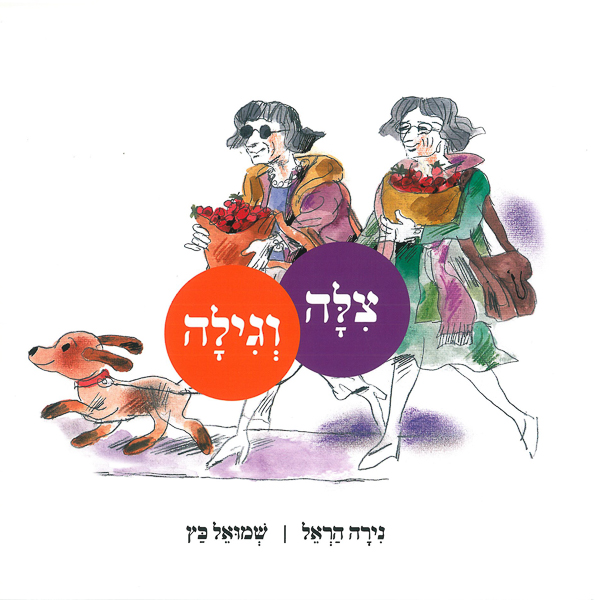Циля и Гиля
Нира Харъэль
Дорогие родители,
Наш рассказ начинается с поездки двух бабушек – подружек и постепенно включает других пассажиров. Пока они добирались до города, каждый из них успел предложить что-то другим, а также получить от них помощь. Взаимная помощь превратила дорожные происшествия в приключения, и в конце из всех машин, стоящих в пробке, водители и пассажиры, которых угостили тортом, посылают поздравления с днем рождения Абигайль, которой исполнилось 6 лет.
"Как хорошо и приятно сидеть братьям вместе"
Циля и Гиля едут в большой город и по дороге помогают людям, которым сложно добраться до своего пункта назначения. Они понимают, как приятно ехать вместе, и как каждый из пассажиров может помочь остальным. Пять человек и щенок едут в машине. Каждый из них должен что-то передать, продать или куда-то быстро добраться. Благодаря благожелательной обстановке продана клубника, передан щенок, а две бабушки, пройдя через все испытания, приезжают к Абигайль с прекрасными подарками. "Как хорошо и приятно сидеть братьям вместе" (Книга Псалмов, 133,1)
Когда незнакомые люди превращаются в партнеров, возникает приятная атмосфера и возможность делать что-то вместе.
"И это к лучшему"
Давным давно жил в Эрец Израэль мудрец по имени Нахум Иш-Гамзо. А почему его прозвали так? Потому что обо всем, что случалось, он говорил "И это к лучшему". Даже когда ему было тяжело, ему удавалось во всем видеть светлые стороны. (Вавилонский Талмуд, Таанит, 21,1). Иногда со всеми нами случается что-нибудь незапланированное или непредвиденное. Но изменения в планах могут дать возможность сделать что-то другое, не хуже прежнего.
Циля и Гиля торопятся на день рождения своей внучки, и вдруг на дороге – пробка! И торт раздавлен, какая беда! Сначала всем немного грустно, но нет худа без добра: бабушки угощают всех приготовленным тортом, так превращается беда в благо, а задержка в "такую милую пробку".
Эанятия в кругу семьи
Некоторые слова в рассказе окрашены в разные цвета. Детям интересно распознавать их по цвету (не читая). Кого описывают розовые слова? В какие цвета окрашены слова "торт"? "клубника"? Так дети могут участвовать в чтении рассказа, называя слова по цвету.
"Как хорошо и приятно сидеть братьям вместе". Иногда встреча с незнакомыми людьми (в автобусе, на игровой площадке) может превратиться в настоящее братство. Постарайтесь вместе вспомнить симпатичных людей, которые помогли вам в неприятной или затруднительной ситуации. Например, молодой человек, который помог вынести коляску из вагона, женщина в очереди к врачу, которая угостила бубликом, дети, которые уступили место на качелях, и т.п.
Обе бабушки любят Абигайль. Предложите детям нарисовать Абигайль и вокруг нее тех, кто ее любит. Возможно, дети захотят нарисовать себя и вокруг себя тех, кто их любит.
Машина проезжает через туннели и мосты. Можно "построить" маршрут машины, отправиться в поездку и на каждой остановке посадить в машину "друга" и помочь ему добраться до места назначения.Вспомните, что в машине Цили и Гили, только торт не был пристегнут ремнем безопасности. Убедитесь, что у вас все "пассажиры" пристегнуты!
Любят ли ваши дети путешествия? Предложите им рассказать о какой-нибудь поездке, реальной или придуманной, куда ездили, кто был с ними, что случилось по дороге. Мы будем рады получить ваши рассказы и рисунки по адресу pj.
Случалось ли вам заблудиться, но при этом попасть в какое-то новое и интересное место? Это возможность рассказать об этом детям: об огорчении и досаде (если они были) , но и о том хорошем, что случилось с вами потом.
"И это к лучшему": непредвиденная остановка прервала приятную поездку. Все пассажиры расстроены из-за пробки. Рассматривая вместе иллюстрации в книжке, поищите неприятные положения, которые впоследствии превращаются в приятные минуты.
Не все любят менять свои планы. Есть ли у вас какой-либо особый способ, который помогает вам и вашим детям при изменении планов?Настольные игры с кубиком и фишками - это популярные игры, в которых сюрпризы могут задержать (вернуть назад), но и обрадовать (продвинуть вперед). Тот, кому нравятся такие игры, может сделать свою доску для игры "По дороге на день рождения". Возвращаемся, когда есть препятствия по дороге, и продвигаемся вперед, когда приятные сюрпризы приближают нас к цели.
Чтобы ободрить себя в минуты, когда что-нибудь не выходит, можно приготовить плакат "И это к лучшему". Напишите это высказывание и дайте детям его разукрасить. Повесьте этот плакат на видном месте в доме, и он будет напоминать вам, что все может уладиться.
Симпатичный щенок нашел себе хороших хозяев, а Абигайль получила шаловливый подарок. Можно сделать пальчиковые куклы Абигайль и щенка (нарисовать или срисовать их из книжки), свернуть, скрепить сшивателем или склеить и надеть на пальцы. Щенок может рассказать Абигайль, что случилось по дороге, а девочка расскажет ему, что она делала, пока ждала в гости бабушек.
"Хороший конец – делу венец". Внучка и обе бабушки празднуют день рождения с чаем и тортом (и щенок тоже участвует - по-своему). Можно устроить маленькое чаепитие и пригласить друзей, которые любят побыть вместе. А в конце какое удовольствие вместе спеть любимую песню "Хинэ ма тов ума наим шевет ахим гам яхад".





